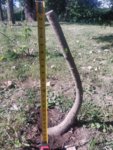I think most of us aim for bonsai that are around 2 feet tall. We want trunks that taper. The height should be something like 6 times the trunk diameter. Some make bonsai that are much fatter/shorter (sometimes called 'sumo') and some make bonsai that are thinner/taller which tend to look more feminine. This is frequently the case with Japanese maples. And there is an extreme of very thin and taller trunks that go with a style called 'literati' where the wanderings of the trunk line are the whole story.
But, getting back to the common proportions, the target is a tree that is about 6x taller than the lower trunk diameter. So, to make a 2 foot tall bonsai you need a trunk that is about 4 inches in diameter. You first chop should be about 1/3rd the final height, or something like 8 inches above the ground (again, to make a 24 inch tall bonsai). So, you see, you are not chopping anywhere near low enough for the thickness of the trunks in your pix.
So, you do that. You chop lower, like 8 to 10 inches above the ground. Next you will choose one of the shoots that pop after the chop (has an interesting ring to it, 'pop after the chop'

) and you will grow it to become the next section of the trunk. The lower/original trunk won't thicken much at all until this new trunk section is almost as thick. This is how we make taper. Let the new trunk shoot grow until it is nearing the thickness of the original trunk, then chop it (keeping about the bottom one third again) and repeat the process. Of course, when these new trunk sections are just soft shoots, you can gently wire them into whatever trajectories you like instead of accepting what nature gives you. With most deciduous species new shoots will lignify in 3 to 6 weeks, so the wire will only be on the stems for a short time, unlike conifers that are much slower to lignify.
Trunk chops are usually, in the spring 'as buds swell', but several species (elms for example) can be chopped in the fall equally well. Acer palmatums are one that should only be chopped in spring. It won't kill the tree, but there will be a lot of unpredictable die back to make you bonsai life much more difficult. I think you could chop your practice willows down this fall (Sep/Oct) and see what comes next spring. Likewise, you might find more desirable (to you) species on sale this fall, at real bargain prices, that you can chop before winter and/or wait until next spring to do so. Just remember, that the base of the tree won't get any thicker if you chop right away. So pick the thickest trunks bases you can find or you will have to plant it and let it grow until it is thick enough to chop.
IMHO, you should move to step 2 now.


